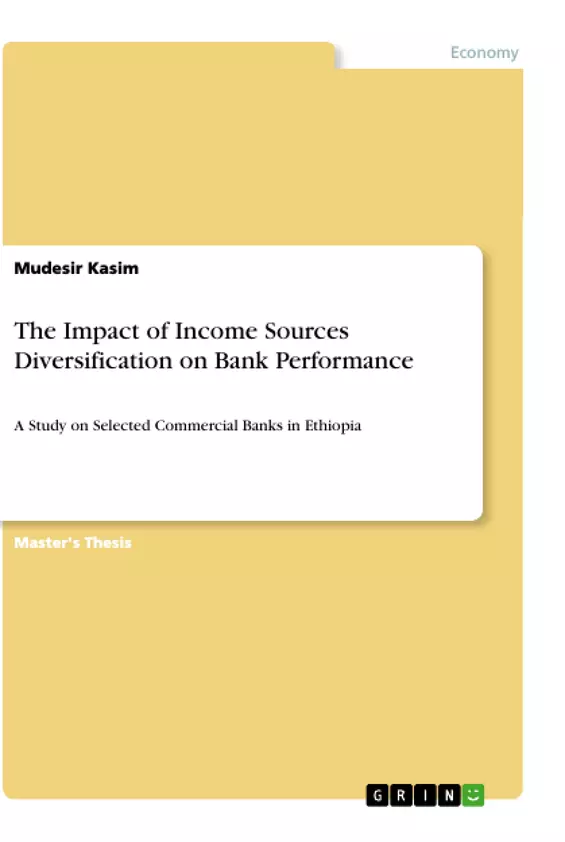The general objective of this study is to investigate the impact of income source diversification on financial performance of commercial banks in Ethiopia. Commercial banks in Ethiopia are currently facing competition from non-bank institutions entry into the activities which was in the past only role of banks. Therefore, banks started searching new income sources rather than focusing only traditional inter-mediation income generating activities. Thus, this study was to examine the impact of income sources diversification on bank performance in case of some selected commercial banks in Ethiopia by using panel data over the period 2010-2015. The study used secondary data collected mainly from each sampled banks annual report financial statements. Since the data is secondary in nature, quantitative approach was adopted. This data was analyzed by using STATA version 12 and Microsoft Excel. Fixed effect model was used, since this model is preferred than the random effect model based on the hausman specification test. Return on asset (ROA) was used as dependent variable while income diversification (Div) as independent variable with control variables such as bank size (BS) in terms of total assets, equity/ assets ratio (EAR), loan/asset ratio (LAR) and expense/income ratio (Exp). The findings of the study show that the level of diversification has a positive impact on financial performance of Ethiopian commercial banks. In addition, the study also revealed that EAR, LAR and BS had positive impact on financial performance while Exp had negative impact. The results of the study are important for bankers to understand how income diversification affects the performance of banks. Therefore, the study recommended that banks should diversify their sources of income into interest and non-interest as well as reduce operating expense in effective way, so as to enhance their performance (ROA).
Inhaltsverzeichnis (Table of Contents)
- CHAPTER ONE
- INTRODUCTION
- 1.1 Background of the study
- 1.2 Statement of the problem
- 1.3 Objectives of the study
- 1.3.1 General objective
- 1.3.2 Specific objectives
- 1.4 Significance of the study
- 1.5 Scope and limitation of the study
- 1.6 Structure of the thesis
- CHAPTER TWO
- RELATED LITERATURE REVIEW
- 2.1 Theoretical Review
- 2.1.1 Definitions of diversification
- 2.1.2 Why Diversification?
- 2.1.3 Approaches to Bank Diversification
- 2.1.4 Financial Performance Measures
- 2.1.5 The Role of banks
- 2.1.6 History of Ethiopian banking sectors
- 2.1.7 Development in Ethiopian banking sector
- 2.2 Empirical Literature
- CHAPTER THREE
- RESEARCH DESIGN AND METHODOLOGY
- 3.1 Research Design
- 3.2 Sources of Data and Method of Data Collection
- 3.3 Target Population, Sample size and Sampling Technique
- 3.4 Econometric Approach
- 3.5 Methods Data Analysis
- CHAPTER FOUR
- EMPIRICAL RESULTS AND DISCUSSION
- 4.1 Descriptive Statistics and Trend Analysis
- 4.1.1 Trend analysis
- 4.1.2 Descriptive statistics
- 4.2 Correlation Analysis
- 4.3 Regression Analysis
- 4.3.1 Testing assumptions of classical linear regression model (CLRM)
- 4.3.2 Random versus fixed effect model
- 4.4 Multiple Regression Analysis
- 4.5 Interpretation of the Finding
- CHAPTER FIVE
- CONCLUSIONS AND RECOMMENDATIONS
- 5.1 Conclusions
- 5.2 Recommendations
- 5.3 Future Research Direction
- REFERENCES
- APPENDICES
Zielsetzung und Themenschwerpunkte (Objectives and Key Themes)
This thesis aims to examine the impact of income diversification on bank performance in Ethiopia. The study uses panel data from selected commercial banks over the period 2010-2015 to assess the relationship between income diversification and return on assets (ROA).- Impact of Income Diversification on Bank Performance
- Financial Performance Measures in Banking
- Role of Non-interest Income Sources
- Econometric Analysis of Bank Performance
- Regulatory Framework and Competition in the Ethiopian Banking Sector
Zusammenfassung der Kapitel (Chapter Summaries)
- Chapter One: Introduction: This chapter provides background information about the Ethiopian banking sector and the importance of income diversification for banks. It outlines the study's objectives, significance, scope, and research methodology.
- Chapter Two: Related Literature Review: This chapter explores relevant theoretical and empirical literature on income diversification and bank performance. It examines different definitions of diversification, the rationale for diversification, and various approaches to bank diversification. The chapter also discusses financial performance measures and the role of banks, specifically focusing on the Ethiopian context.
- Chapter Three: Research Design and Methodology: This chapter outlines the research design, data sources, and data collection methods used in the study. It explains the target population, sample size, sampling technique, econometric approach, and data analysis methods. The chapter also details the variables used in the study, including return on assets (ROA), income diversification (Div), and control variables like bank size (BS), equity/assets ratio (EAR), loan/asset ratio (LAR), and expense/income ratio (Exp).
- Chapter Four: Empirical Results and Discussion: This chapter presents the results of the study, including descriptive statistics, correlation analysis, and regression analysis. It analyses the impact of income diversification on bank performance and examines the influence of other factors on bank profitability. The chapter discusses the findings and their implications for the Ethiopian banking industry.
Schlüsselwörter (Keywords)
The study's main focus revolves around the impact of income diversification on bank performance. The core concepts and research areas include income diversification, bank performance, ROA, commercial banks, fixed effects, and financial performance measures. The study also explores the implications of income diversification strategies for the Ethiopian banking sector, considering the competitive landscape and regulatory environment.- Quote paper
- Mudesir Kasim (Author), 2016, The Impact of Income Sources Diversification on Bank Performance, Munich, GRIN Verlag, https://www.grin.com/document/535024



